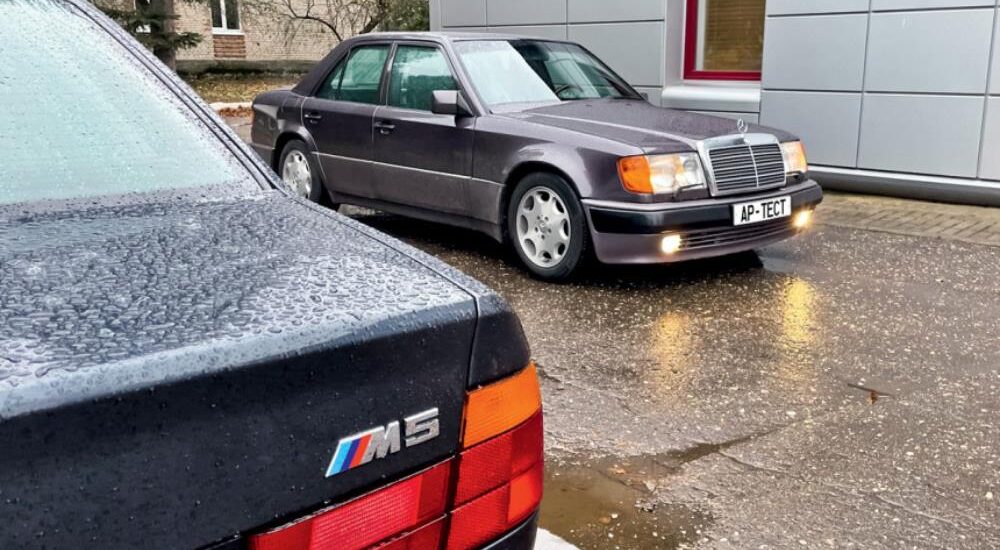Когда Mercedes объявил о выпуске W124, BMW ответила моделью E34. Мюнхенцы ответили громко и четко, выпустив M5, а Штутгарт быстро отреагировал моделью 500 E. Интересно, что, несмотря на разительные различия между этими суперседанами, у них была общая точка отсчета – оба они начинали свой путь в кузове грузовика.

Проект W124 начался в 1977 году с первоначального дизайна, разработанного Питером Пфайффером и Йозефом Галлитцендорфером, и был доработан руководителем центра дизайна Бруно Сакко.
Тон соперничеству, несомненно, задала компания BMW в 1980-х годах, движимая стремлением обогнать Mercedes. Конкуренция была настолько жесткой, что мюнхенцам приходилось удваивать усилия, чтобы сохранить погоню. Чтобы получить преимущество, им нужен был прорыв, который и произошел с выпуском “семерки” E32 в 1986 году, а годом позже – BMW 750i с двигателем V12. Задача состояла в том, чтобы повторить этот успех с “пятеркой”.
Седаны E34, выпущенные в 1988 году, были созданы с единственной целью – превзойти грозный W124. Спустя четыре года после своего дебюта Mercedes все еще оставался чудом автомобильной техники. Во время нашего ретро-теста я углубился в BMW Praxis, дилерский каталог, используемый для обучения продавцов новой “пятерке”. Это 240-страничное руководство – сокровищница подробностей о E34, наполненная информацией, которую редко можно найти в других изданиях.
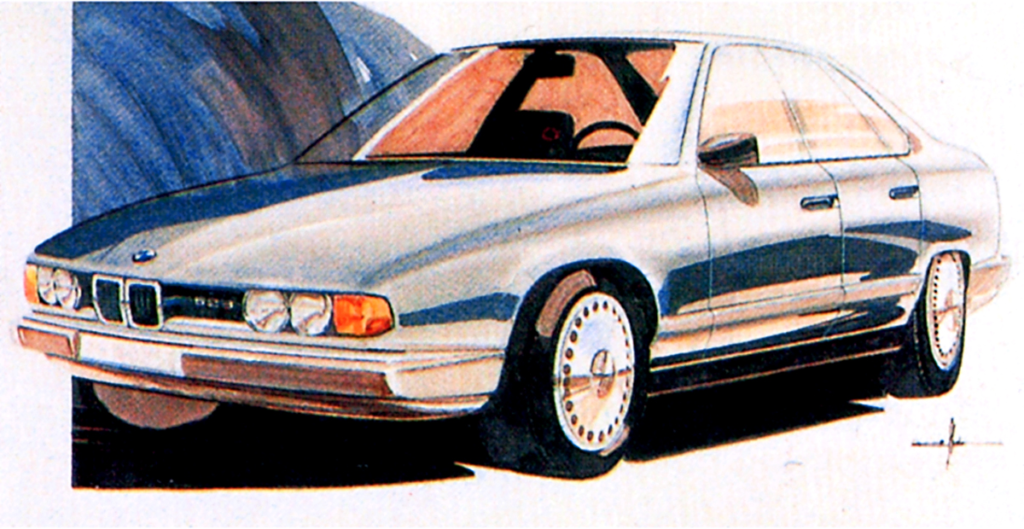
Итальянские гены E34 были описаны в 1982 году Эрколе Спадой. Работа над “Пятеркой” была продолжена Джеем Мэйсом и завершена под руководством Клауса Люте.
От маркетинговых стратегий до технических инноваций – соперничество было острым. BMW проанализировала доли рынка среди представителей различных профессий, отметив, что “Пропеллер” предпочитают менеджеры среднего звена, а “Звезду” – топ-менеджеры и фрилансеры. BMW также заявляла об улучшении аэродинамики, утверждая, что по сравнению с предшественником она улучшилась на 18 % и достигла коэффициента сопротивления 0,30, сохранив при этом свой культовый дизайн решетки радиатора. При этом они намекнули, что их результаты могли бы быть еще лучше, если бы не стандартная шинная политика – это подколка в адрес Mercedes, чьи лучшие аэродинамические показатели были достигнуты с помощью более узких шин.

Баланс между функциональностью (вертикальная ось) и эстетикой (горизонтальная ось), как это воспринимается BMW. Получается, что Lancia наименее практична, в то время как Audi считается наименее красивой.
На такие инновации, как уникальная система стеклоочистителей Mercedes, очищающая 86 % лобового стекла, BMW ответил удлиненными стеклоочистителями, которые сохранили площадь очистки, но добавили механизм для лучшей работы щеток на низких скоростях. Аналогично, если Mercedes мог похвастаться автоматическим подогревом зеркал и форсунок, то BMW представил подогреваемый механизм замка, активирующийся при удержании дверной ручки – особенность продуманной конструкции.

Очевидно, насколько по-разному компании работали с интерфейсом. Для Mercedes оптика и решетка радиатора выступают в качестве аэродинамического инструмента, помогающего снизить подъемную силу. Для BMW фары – это прежде всего лицо бренда. Тем не менее, каталог BMW Praxis приводит интригующие цифры: чтобы преодолеть сопротивление воздуха на скорости 180 км/ч, E34 требуется 64 л.с., а на скорости 200 км/ч – 87 л.с. Это на 20% меньше, чем у его предшественника, E28, с похожим акульим носом.
В каждой модели были представлены особенности, призванные превзойти другую. На знаменитую пятизвенную заднюю подвеску Mercedes BMW ответила усовершенствованием существующей системы E34, включая электронноуправляемые амортизаторы и систему рулевого управления Servotronic. BMW также ответила на ASR Mercedes своей продвинутой системой ASC+MSR, которая решает не только проблему тяги, но и блокировки колес при замедлении.
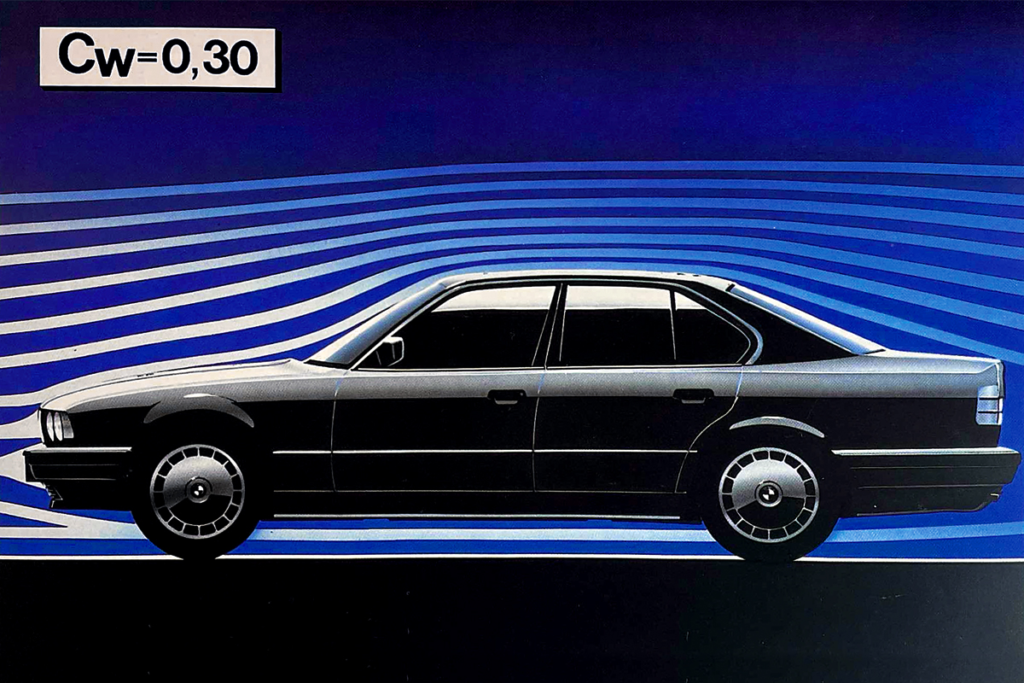
В каталоге даже приводится обоснование характеристик управляемости M5, предполагая, что BMW намеренно настроила шасси на нейтральную или легкую недостаточную поворачиваемость, которая может переходить в избыточную при нажатии на педаль газа, предположительно, чтобы противостоять хвостовому характеру Mercedes.
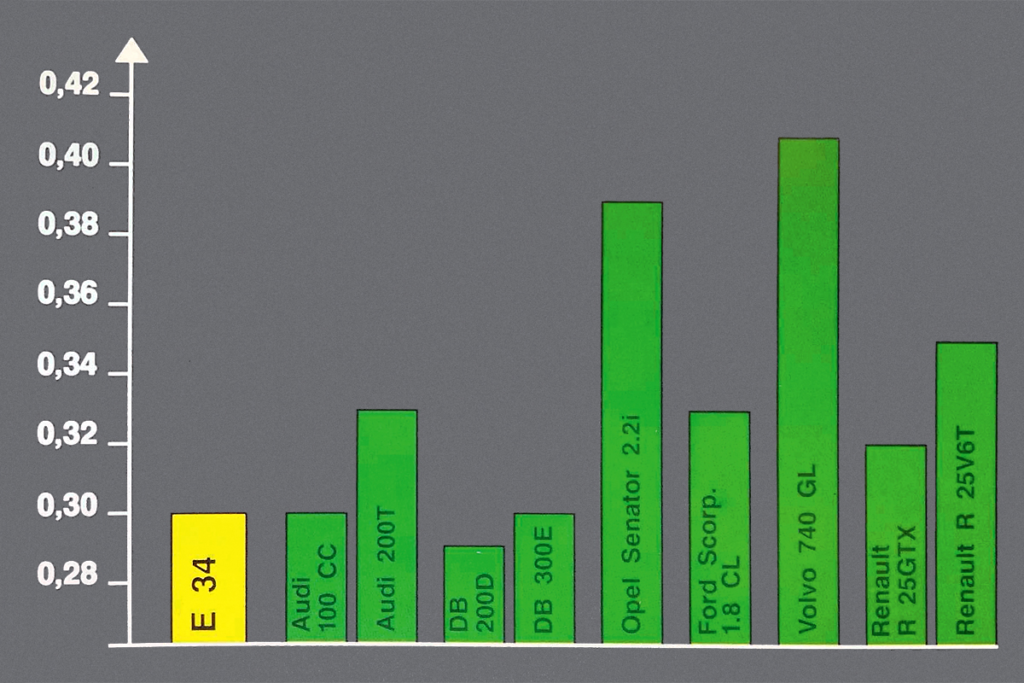
Аэродинамика как классиков, так и современников. Чтобы догнать Mercedes, BMW отозвала сотрудников из Audi.
Эта непрекращающаяся битва не только раздвинула технологические границы, но и подчеркнула глубоко укоренившееся соперничество. Хотя E34 на мгновение опередил W124, он не смог повторить революционное влияние V12 E32. Несмотря на общую платформу с “семеркой”, “пятерка” всегда казалась на шаг позади своего штутгартского собрата, гоняясь за такими инновациями, как полный привод и усовершенствования в области безопасности, которые первыми внедрил Mercedes.
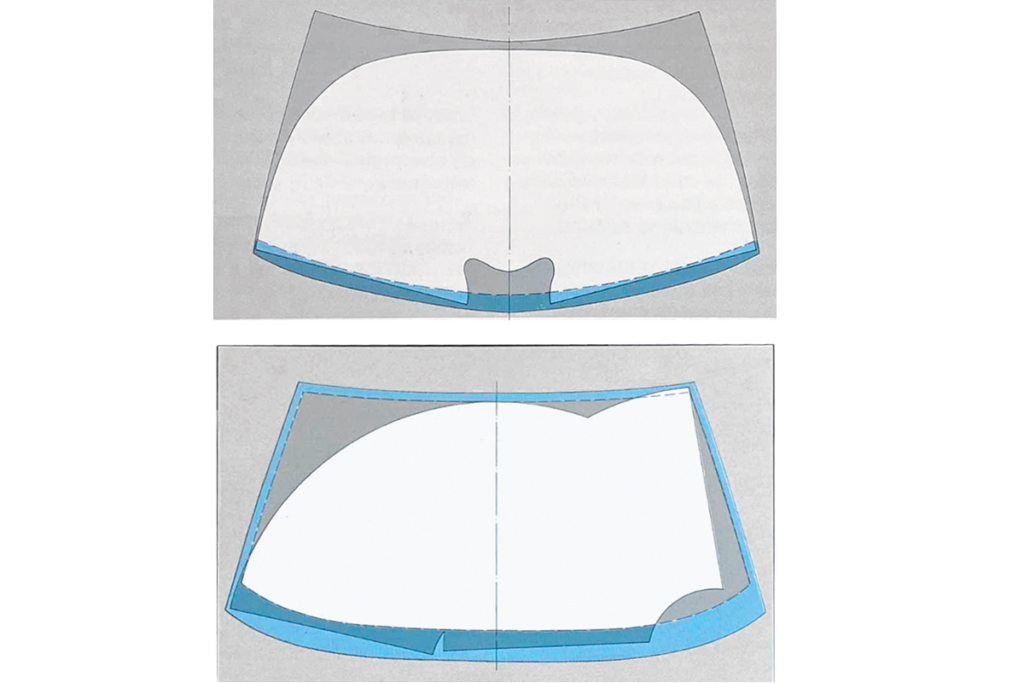
Стеклоочиститель Mercedes достигает верхних углов и обеспечивает рекордную для автомобильной промышленности площадь очистки лобового стекла. BMW настаивает на том, что верхний левый угол более важен для видимости на светофорах.
BMW M5 остается свидетельством этой ожесточенной конкуренции, воплощая в себе неустанное стремление к автомобильному совершенству и инновациям. Эти соперники, подталкивая друг друга к большим высотам, оставили после себя наследие инженерного мастерства и производительности, которое продолжает вдохновлять автомобильный мир.
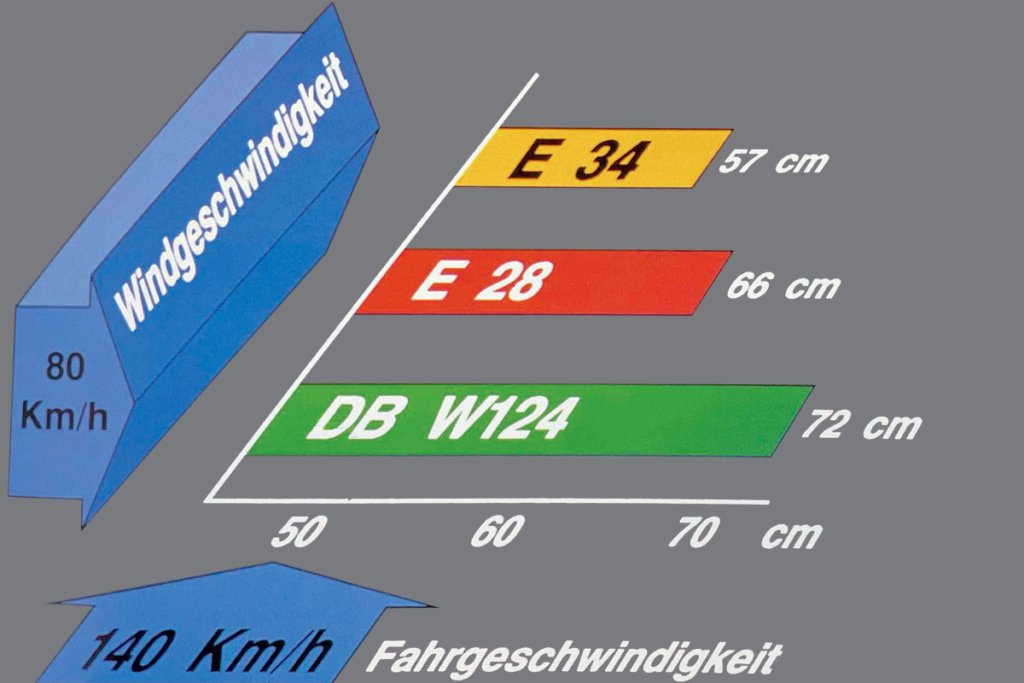
Еще одна причина подчеркнуть превосходство над Mercedes: при боковом ветре E34 заносит меньше, чем W124.
Когда Mercedes представил W124, BMW быстро отреагировал на это моделью E34, предвещающей появление собственного шедевра – M5. Штутгартский ответ, 500 E, ознаменовал начало захватывающего соперничества между двумя совершенно разными суперседанами, имеющими удивительное происхождение: каждая модель начинала свою жизнь на шасси грузовика.
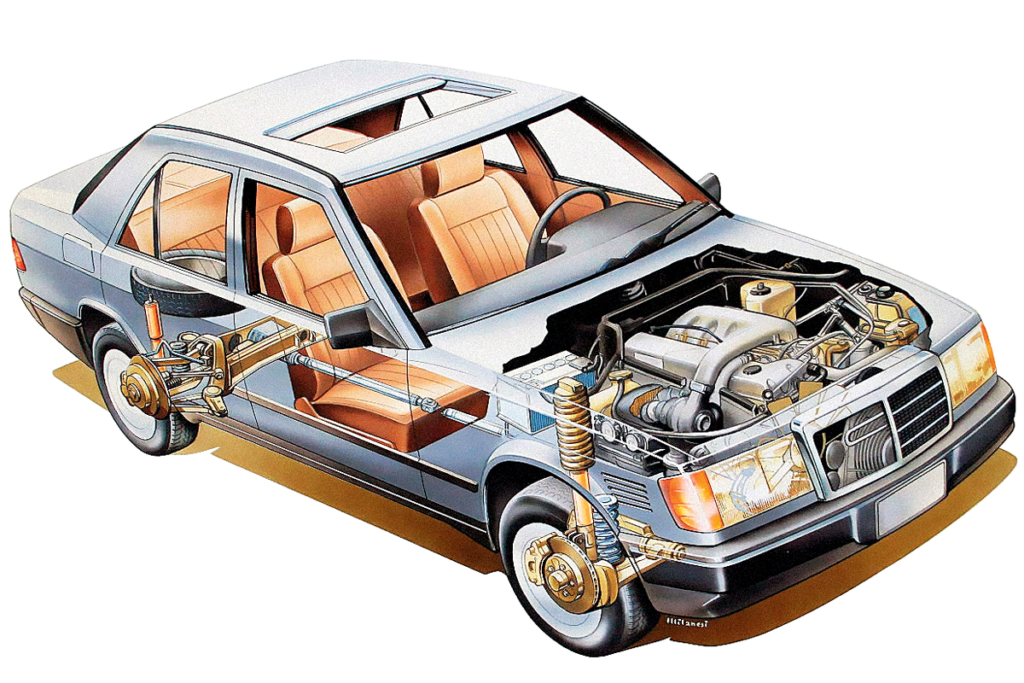
Главной технической жемчужиной шасси W124 является задняя многорычажная подвеска, которая появилась чуть раньше на небольших седанах W201 и впоследствии была установлена практически на все легковые автомобили Mercedes. Он был скопирован многими другими производителями. С некоторыми изменениями эта базовая пятизвенная схема используется и по сей день.
В 1980-х годах компания BMW стремилась превзойти Mercedes. Штутгарт был грозен и вынуждал Мюнхен удваивать усилия, чтобы не отстать. Чтобы превзойти Mercedes, BMW требовалось нечто экстраординарное. Они сделали это в 1986 году, когда дебютировала “семерка” E32, а еще через год поразили автомобильный мир, выпустив BMW 750i с двигателем V12. Задача состояла в том, чтобы повторить этот успех с “пятеркой”.
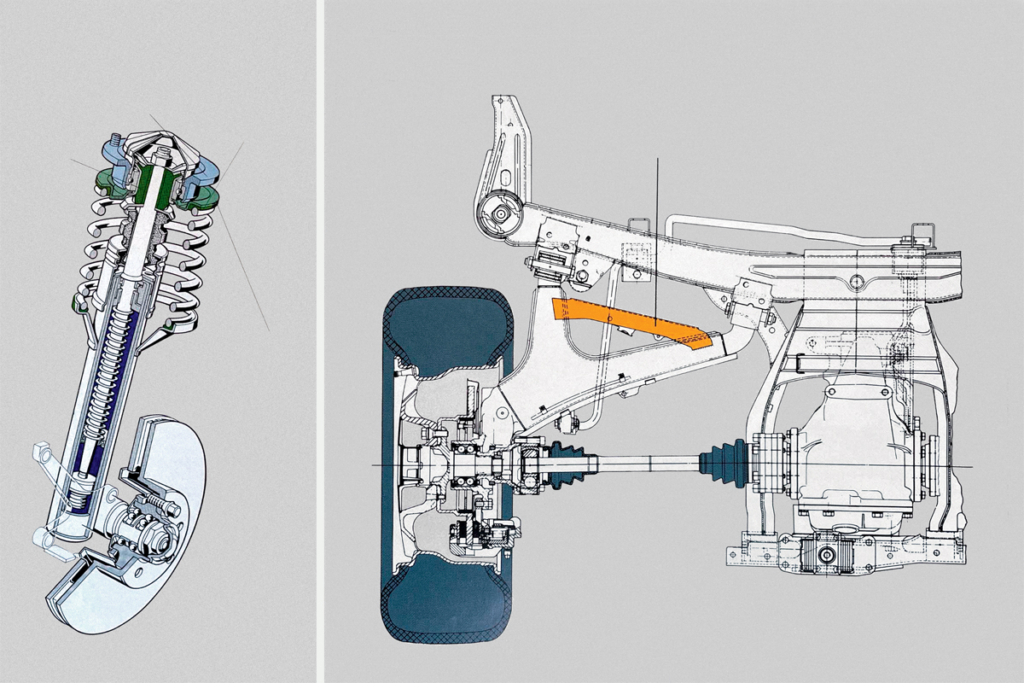
Для всех версий E34 выше BMW 525i и 524td были предусмотрены стойки McPherson с отдельными пружинами и амортизаторами. Сзади наклонные подлокотники были укреплены скобами. Это была последняя “пятерка” с такой олдскульной задней осью. В качестве опции, за исключением M5, предлагалась более жесткая спортивная подвеска.
Выпущенные в 1988 году седаны E34 были нацелены на одну цель – выдающийся W124. Через четыре года после своего дебюта Mercedes все еще олицетворял зенит автомобильной инженерии.
Во время нашего ретроспективного тестирования я провел несколько дней с уникальным дилерским каталогом BMW Praxis, предназначенным для обучения торгового персонала новым “пятеркам”. Эта 240-страничная библия E34 охватывает каждую мельчайшую деталь и конструкторское решение автомобиля. Она наполнена уникальными сведениями и стоит 30 000 рублей, что говорит о ее ценности. Примечательно, что W124 упоминается почти на каждой странице, подчеркивая очевидную одержимость.
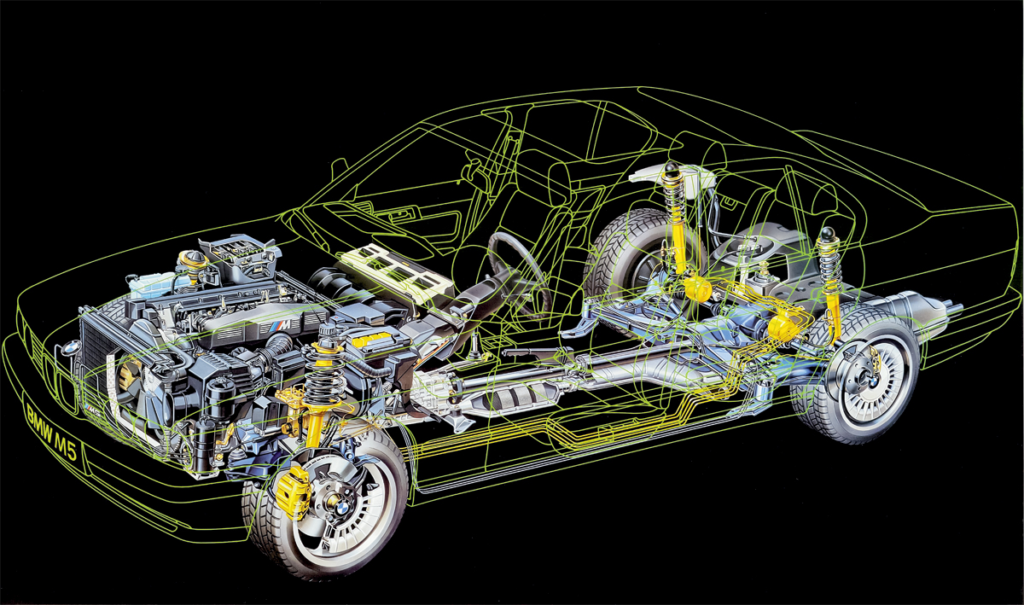
Аналогичная сложная многорычажная подвеска BMW появилась только в 1989 году на купе E31, а затем на “семерке” E38 и “Пятерке” E39. Но M5 E34, даже до того, как был выпущен Mercedes 500 E, стандартно оснащался задними амортизаторами с гидравлическим механизмом самовыравнивания для поддержания постоянных углов развала колес и дорожного просвета.
Битва началась с маркетинговых стратегий, причем BMW провела детальное сравнение долей рынка среди представителей различных профессий. Бренд “Пропеллер” больше пришелся по вкусу менеджерам среднего звена, в то время как “Звезда” нашла отклик среди топ-менеджеров и фрилансеров. BMW также похвасталась инженерными достижениями, заявив о значительном улучшении аэродинамики по сравнению с предшественником и достижении коэффициента сопротивления 0,30, сохранив при этом знаковый отрицательный наклон ноздрей. Компания тонко намекнула, что эти результаты могли бы быть еще лучше, намекнув, что конкуренты, такие как Mercedes, использовали более узкие шины для достижения оптимальных показателей.
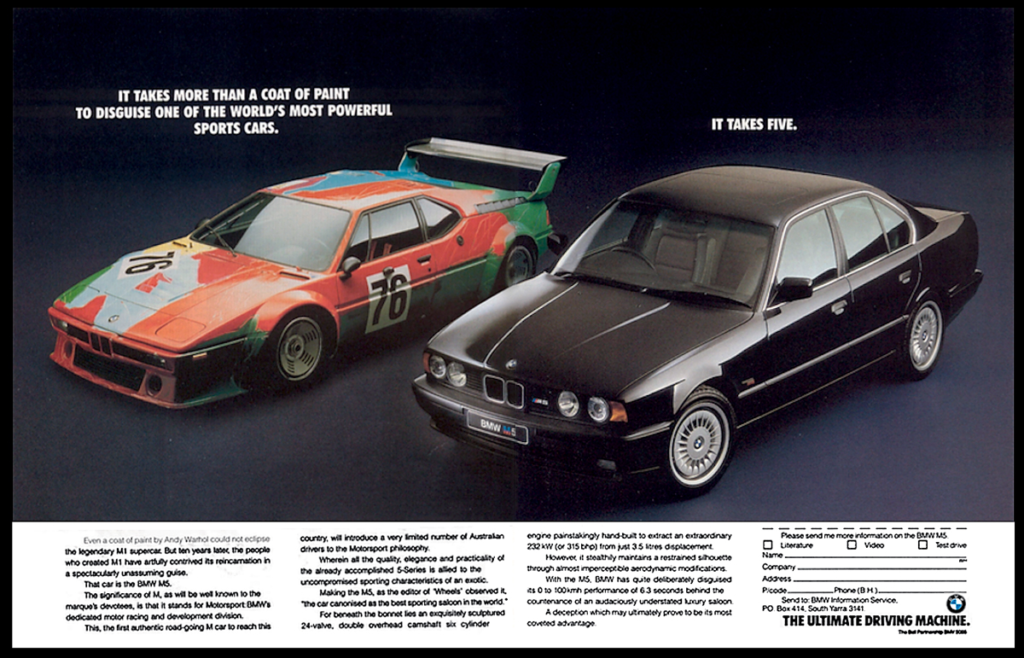
Родословная двигателей M5 традиционно восходит к “шестерке” M88 BMW M1, хотя истинным прародителем был BMW 3.0 CSL. Версия M88/3 без сухого картера была предназначена для E28 M5 в Европе, в то время как первый двигатель с маркировкой S38B35 был его “каталитической” версией для Америки. Двигатели S38 на E34 унаследовали железный блок и 24-клапанную головку DOHC.
BMW повторила инновационную систему стеклоочистителей Mercedes, которая очищает 86% стекла, увеличив радиус действия дворников и добавив механизм в основании для улучшения сцепления лезвий на низких скоростях. Они также представили уникальную функцию, при которой нажатие и удержание дверной ручки активирует обогрев замка – продуманное дополнение для холодного климата.
От складных задних подголовников, управляемых сервоприводами вместо пружин, до более сложной системы контроля тяги, которая управляет как потерей тяги, так и внезапным замедлением, BMW, казалось, была намерена не только конкурировать, но и лидировать в инновациях. Новые функции каждой модели были направлены на то, чтобы превзойти другую, при этом BMW постоянно совершенствовал свои конструкции, чтобы реагировать на достижения Mercedes.
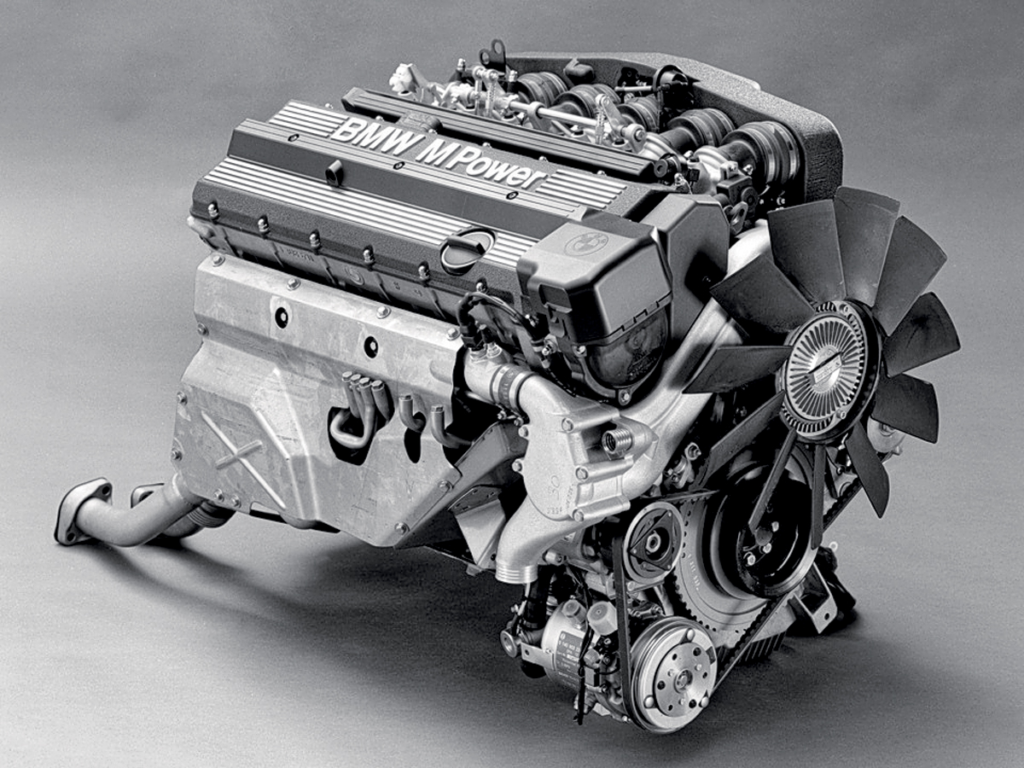
Двигатель S38B36 (315 л.с.) до рестайлинга M5 на самом деле имел рабочий объем 3535 куб.см, но был обозначен как 3.6, чтобы отличать его от двигателя предшественника с рабочим объемом 3453 куб.см на M5 E28.
Более того, в каталоге BMW приводилось обоснование характеристик управляемости M5, указывающее на намеренную настройку на нейтральную или легкую недостаточную поворачиваемость, которая может переходить в избыточную при ускорении – возможно, это намек на “дрифтовый” характер “124”.
Это соперничество не только раздвинуло границы автомобильных технологий, но и подчеркнуло напряженный дух конкуренции между двумя брендами. Хотя E34 ненадолго опередил W124, ему не удалось повторить новаторское влияние двенадцатицилиндрового E32. Несмотря на общую платформу с “семеркой”, “пятерка” всегда была в лидерах, внедряя такие инновации, как кузов универсал, полный привод и улучшенные системы безопасности, которые повторяли те, что были разработаны Mercedes. BMW M5 остается памятником этому ожесточенному соперничеству, демонстрируя, как конкуренция способствует инновациям и совершенству в автомобильной промышленности.
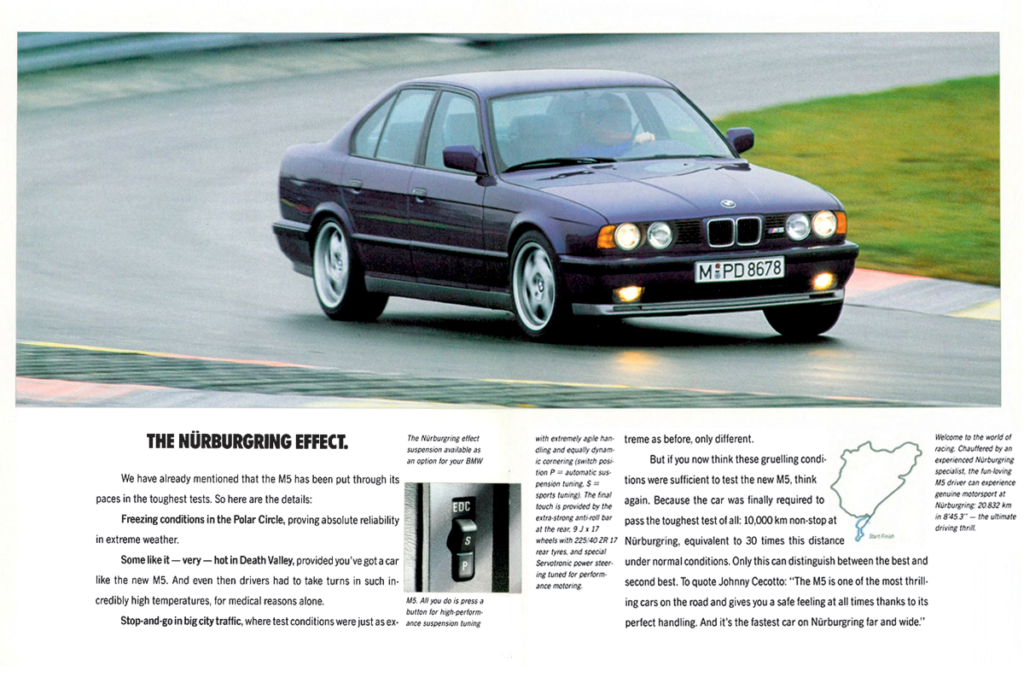
Эффект Нюрбургринга означает, что во время тестов седан BMW M5 с адаптивными амортизаторами EDC проехал без остановок десять тысяч километров по “Северной петле” Нюрбургринга и показал лучшее время – 8 футов 45,3 дюйма (на трассе протяженностью 20 832 км).
Три года назад, в честь 30-летия Mercedes 500 E, пресс-служба Porsche опубликовала интервью с Михаэлем Хёльшером, руководителем проекта Typ 2758. Последующие выступления Хёльшера в подкасте пролили свет на нюансы разработки этой культовой модели. Он пояснил, что компоновка седана, выбор двигателя и трансмиссии от родстера 500 SL, а также его дизайн и аэродинамика определялись исключительно Mercedes. Перед Porsche была поставлена задача интегрировать эти компоненты в шасси W124, которое изначально не было рассчитано на установку двигателей V8.
Это сотрудничество потребовало значительной адаптации, включая перенос впускных каналов, перекладку тормозных и топливных магистралей, корректировку центрального тоннеля, расширение трассы и проведение комплексной программы ходовых испытаний. Интересно, что Mercedes решил не включать в этот проект тюнинг для Нюрбургринга, подчеркнув тем самым, что для Porsche спецификации клиента имели первостепенное значение.
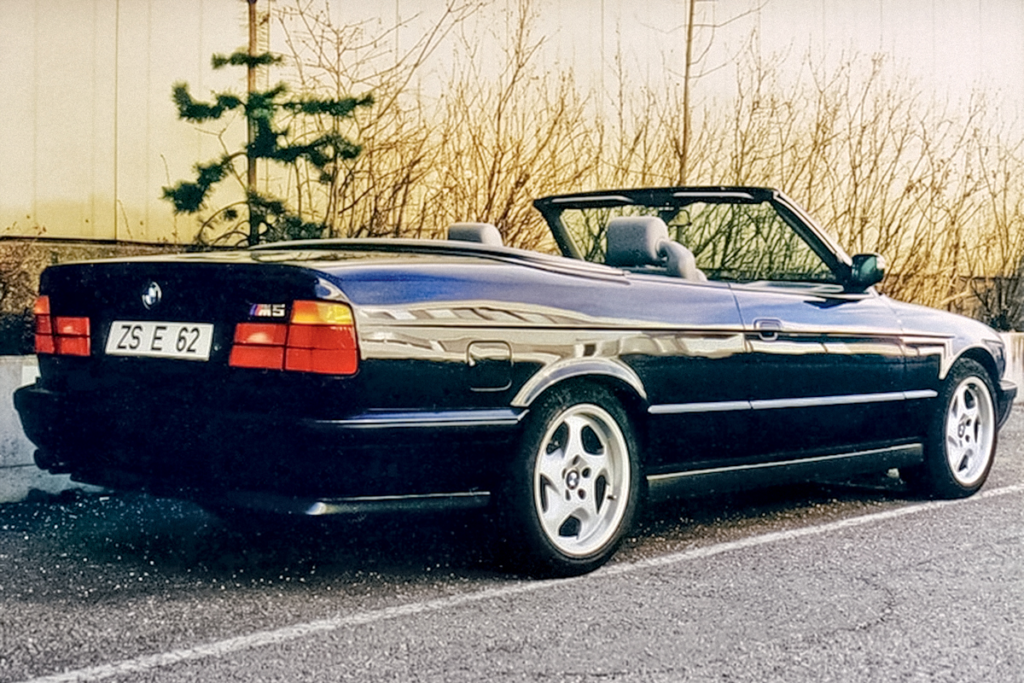
На Женевском автосалоне 1989 года должен был быть показан кабриолет M5 с кузовом E35, но за неделю до премьеры BMW опасалась, что это повредит спросу на открытый M3, и отменила проект. Прототип был представлен только в 2009 году.
Заметной инновацией из Цуффенхаузена стала разработка электронной системы управления двигателем. Действительно, модель 500 E стала новаторской как для Mercedes, так и для Porsche, поскольку это был первый автомобиль, оснащенный системой CAN-шины.
Хёльшер также развенчал миф о том, что 500 E не мог быть размещен на сборочном конвейере в Зиндельфингене из-за его слишком широких передних крыльев, которые, по слухам, были разработаны Porsche. Он объяснил, что на самом деле эти крылья были придуманы дизайнерами Mercedes, которые прекрасно знали об ограничениях на сборочной линии. Решение не переоборудовать оборудование завода в Зиндельфингене для установки более широких крыльев, а передать некоторые этапы производства Porsche, было экономически эффективной стратегией. В связи с этим возникает интригующая возможность: возможно, Mercedes планировал собирать этот особый седан в уникальном месте, вдали от стандартных производственных линий, подобно тому, как это делает BMW.
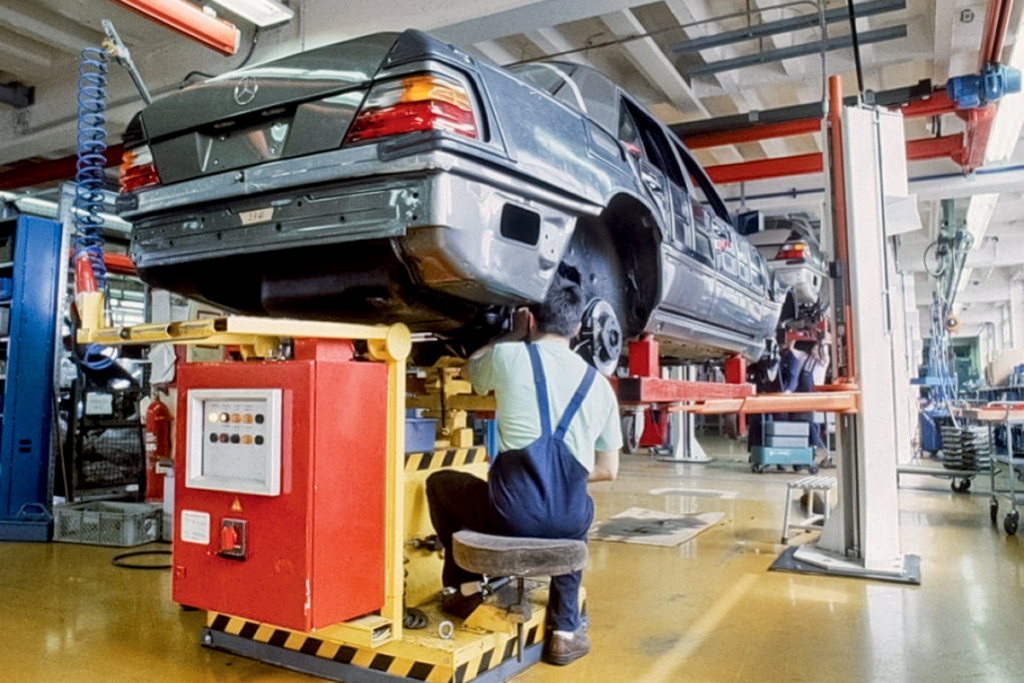
На заводе Porsche автомобили Mercedes собирались без конвейера, на подъемниках и тележках. VIN-код этих автомобилей должен включать цифры 124.036.
В конечном итоге Mercedes 500 E собирался в трех местах. Штампованные кузовные панели доставлялись из Зиндельфингена в Цуффенхаузен, где Porsche добавлял детали и собирал их в рамы в здании Reutter Bau, названном так в честь исторического Reutter Karosseriewerk, кузовного цеха, который работал с Фердинандом Порше с 1906 года и сыграл важную роль в создании ранних кузовов автомобилей Porsche. После первичной сборки рамы были возвращены в Зиндельфинден для покраски, а затем обратно в Цуффенхаузен для окончательной сборки на заводе Rössle Bau, где ранее производился Porsche 959.
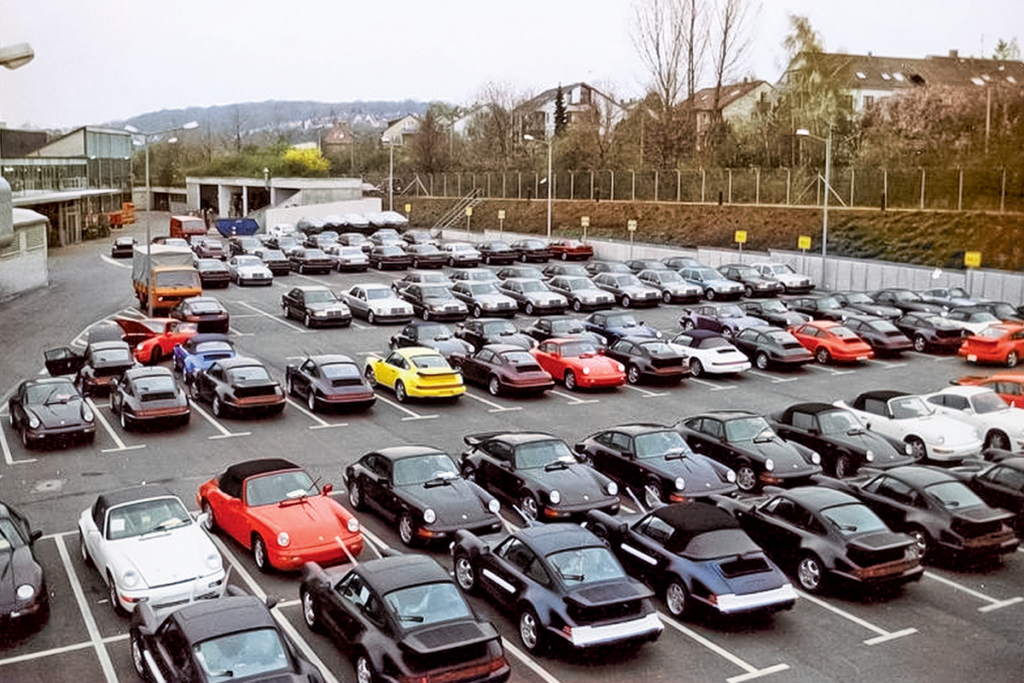
Начало 90-х, готовая продукция на заводе в Цуффенхаузене: различные Porsche 964 и сорок Mercedes на заднем плане.
Логистическая сложность этого процесса была значительной: на производство каждого автомобиля уходило 18 дней. Несмотря на это, процесс производства оказался более эффективным, чем у BMW M5. Изначально Mercedes планировал, что Porsche будет выпускать по десять автомобилей ежедневно, но из-за огромного спроса темпы производства удвоились.
Стоимость автомобиля была выше, чем у S-класса, и составляла 135 000 немецких марок. Пик спроса и производства пришелся на 1992 год, но вскоре модель 500 E превратилась в E 500 в рамках фейслифтинга 1993 года, который превратил всю серию “124” в E-класс. Хотя конструкция осталась прежней, повышение цены до 146 000 марок привело к снижению продаж, что привело к прекращению производства в 1995 году. Однако менее мощная модель 400 E (позже E 420) продолжала выпускаться до 1996 года в удвоенном количестве.
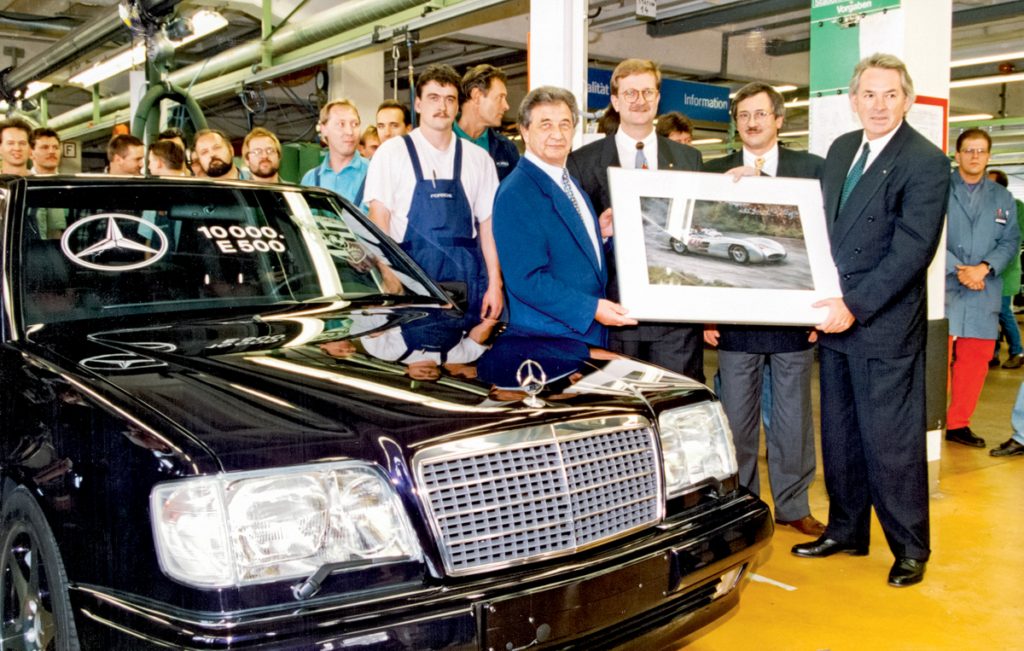
10-тысячный “пятисотый” Mercedes был выпущен в октябре 1994 года — уже с обновленным индексом E 500. После этого было собрано еще 479 единиц техники. Автомобиль был подарен Хансу Херрманну, который в 50-е годы выступал за Mercedes в Формуле-1, а в 1970 году выиграл самый первый Ле-Ман за Porsche.
Этот проект не только стабилизировал финансовое положение Porsche, но и заложил основу для будущих проектов, таких как Audi RS2, где Porsche оказала большее инженерное влияние. Лидерство Михаэля Хёльшера вышло за рамки этого проекта, он участвовал в разработке Carrera GT и Porsche 918 Spyder до своего ухода на пенсию в 2016 году.
В 1993 году компания Mercedes, осознав прибыльность моделей с высокой производительностью благодаря проекту 500 E, решила сохранить эксклюзивность этой “икры” автомобильного бизнеса, что привело к выпуску первого Mercedes C 36 AMG и положило начало будущим высокопроизводительным инновациям, хорошо известным сегодня.
Фото: BMW | Mercedes-Benz | Сергей Знаемский
Это перевод. Оригинал статьи вы можете прочитать здесь: “Друг друга: как появились BMW M5 и Mercedes-Benz 500″ из нашего обзора

Опубликовано Июнь 20, 2024 • 12м на чтение

